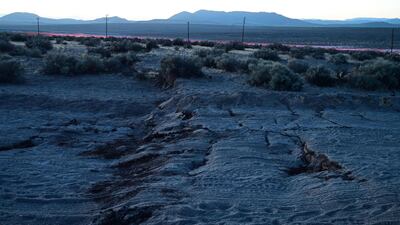Officials in Southern California expressed relief on Saturday that damage and injuries were not worse after the largest earthquake the region has seen in nearly 20 years, while voicing concerns about the possibility of major aftershocks in the days and even months to come.
No fatalities or major injuries were reported after Friday night's 7.1-magnitude earthquake, which jolted an area from Sacramento to Mexico and prompted the evacuation of the Navy's largest single landholding, Naval Air Weapons Station China Lake in the Mojave Desert.
The quake struck at 8.19pm on Friday and was centered 11 miles (18 kilometres) from Ridgecrest, the same area of the desert where a 6.4-magnitude temblor hit just a day earlier. It left behind cracked and burning buildings, broken roads, obstructed railroad tracks and leaking water and gas lines.
The light damage was largely due to the remoteness of the area where the earthquake occurred, but Gov Gavin Newsom cautioned after touring Ridgecrest that "it's deceiving, earthquake damage. You don't notice it at first".
He estimated more than $100 million in economic damages and said President Donald Trump called him to offer federal support in the rebuilding effort.
"He's committed in the long haul, the long run, to help support the rebuilding efforts," Mr Newsom said of Mr Trump.
Only 28,000 people live in the Ridgecrest area, which is sandwiched between more populated areas of Southern California and Las Vegas' Clark County. But seismologists warned that the area could see up to 30,000 aftershocks over the next six months.
With the possibility of aftershocks and temperatures forecast to reach 100 degrees (38 Celsius) over the next several days, officials were taking precautions.
The California National Guard was sending 200 troops, logistical support and aircraft, Maj Gen David Baldwin said. The Pentagon had been notified, and the entire California Military Department was put on alert, he said.
Naval Air Weapons Station China Lake said in a Facebook post that nonessential workers were evacuated and operations halted. The epicentres of both quakes were on the base, and officials said they are continuing to assess damage. Officials said most employees live off the base and in Ridgecrest, but they authorised the evacuation so those who live on base can be eligible for reimbursements.
The California Office of Emergency Services brought in cots, water and meals and set up cooling centers in the region, Director Mark Ghilarducci said.
State highway officials shut down a 30-mile (48-kilometre) section of State Route 178 between Ridgecrest and the town of Trona southwest of Death Valley because of a rockslide and severe cracking. The move left Trona temporarily cut off. California Department of Transportation spokeswoman Christine Knadler said crews worked through the night to patch the roadway, but it remained rough and uneven.
In Ridgecrest, local fire and police officials said they were initially swamped by calls for medical and ambulance service. But police Chief Jed McLaughlin said there was "nothing but minor injuries such as cuts and bruises, by the grace of God."
Two building fires – one involving a mobile home – were quickly doused, Mr McLaughlin said, and natural gas lines where leaks were reported were shut off.–
When asked to describe what he has been going through in the past two days, the chief said: "Grief, shock and then, for me, pride in what I've seen from here, my people. It's been a vast range of emotions, and I think the whole community's going through that."

